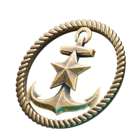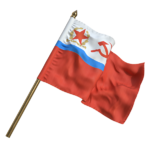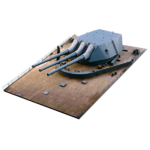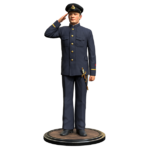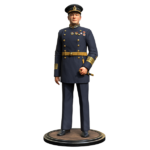In the Service of the Motherland Collection
"Renowned admirals, outstanding engineers, glorious naval victories, innovative projects, battleships wielding their powerful armament—this is the story of the Russian and Soviet Navy."
The overall collection comprises eight sub-collections. Each sub-collection grants a different reward. There is a reward for obtaining all 32 items. Duplicates can be exchanged at a 5:1 ratio.
Contents
Sub-Collections
Admiral Nikolay Gerasimovich Kuznetsov

In May 1940, the generalship and admiralty were introduced in the Armed Forces of the Soviet Union. Accordingly, the People's Commissar for the U.S.S.R. Navy Nikolay Gerasimovich Kuznetsov, previously being Flagman Flota 2 Ranga (Flag Officer 2nd rank) was awarded the rank of Admiral. The highest rank in the naval hierarchy was Admiral Flota, but at that time, no one was considered worthy of the title.
It wasn't until May 1944 that the People's Commissar for the Navy, Kuznetsov, and his deputy, Admiral Isakov, were the first to be awarded the rank of the Admiral Flota (Admiral of the Fleet). It was around that time that the corresponding insignias were developed. As the decree of 1940 implied the correspondence of the Admiral Flota rank to the Army General of the Land Forces, four stars were placed on the Admiral Flota shoulder boards of 1944 by analogy with the army ranks. In May 1945, a special decree equated the ranks of the Admiral Flota to the Marshal of the Soviet Union. At the same time, the Marshal-type shoulder boards with the emblem of the U.S.S.R. and one big star were introduced.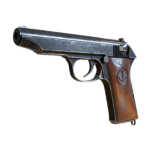
The harsh winter of 1941–1942 was a severe test not only for the citizens and defenders of the blockaded Leningrad. Weapons and military equipment also was seriously affected. Thus, the TT pistol, being in service with the army and navy, often malfunctioned in freezing temperatures. Kontr-Admiral Rall, Chief of Staff of the Baltic Navy, requested the higher authorities to produce a more reliable pistol at one of the Leningrad plants to arm the naval officers.
After considering the issue, the Leningrad Regional Committee of the Communist Party appointed Plant No. 181 to design and manufacture the first batch of new pistols as soon as possible. Having received just drawings of the parts in January 1942, the masters at the plant made a prototype by hand. In March 1942, it was successfully tested at the temperature of −30 degrees Celsius. The pistol, named Baltiets in honor of the Baltic Navy, had a 7.62 mm caliber and a magazine for eight cartridges. Under the blockade, a total of 14 Baltiets pistols were made by hand. Admiral Nikolay Gerasimovich Kuznetsov, the People's Commissar for the Navy, was given the pistol with serial number 2 and the dedicatory inscription as a present.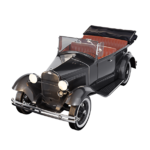
In 1933, Nikolay Gerasimovich Kuznetsov was appointed the Commander of light cruiser Chervona Ukraina. Under his command, the cruiser soon became the best ship of the Black Sea Navy in terms of combat training. The Soviet statesmen visited Chervona Ukraina many times. Among them was Sergo Ordzhonikidze, the People's Commissar of Heavy Industry, who was in charge of shipbuilding and production of Soviet cars. Impressed by the crew's training level and the ship's excellent condition, he presented the cruiser Commander with the GAZ-A.
GAZ-A was the first Soviet passenger car of mass production. It was produced between 1932 and 1936 and was a licensed copy of the American Ford Model A, as it was impossible for the Soviet industry of the early 1930s to assimilate the production of an original model. A simple five-passenger phaeton, equipped with a 40 hp engine and bearing similar design to truck GAZ-AA, was supposed to be used not only for civilian needs. The Red Army was massively supplied with GAZ-A to be used mainly as a command vehicle.Reward
Completing this sub-collection provides the following reward:
| Icon | Details |
|---|---|

|
Second Flag - Ability to mount a second flag on all Soviet Cruisers. |
Main Battery
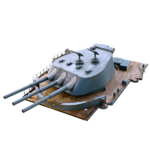
Having analyzed the experience of the Russo-Japanese War of 1904–1905, the Admiralty command came to the conclusion that the main caliber guns of the new battleships should have much better ballistics and range of fire than the 305 mm, 40 caliber guns installed on the majority of the Russian squadron battleships. Initially, the armament of the designed battleship was supposed to be placed in double-gun turrets, but the Naval General Staff insisted on installation in triple turrets.
The new 305 mm, 52 caliber gun was designed at the Obukhov Plant in St. Petersburg. The first copy was made in 1907. The three-gun turret was developed at the Metal Plant in St. Petersburg. The turrets of the Baltic battleships (Sevastopol, Gangut, and others) were protected by 203 mm thick armored plates. The maximum gun elevation angle was 25 degrees, which provided a 24 km range of fire of the 1911 shell. Later, after the modernization of one of the battleships, the gun elevation angle increased to 40 degrees, which extended the range of fire to 30 km.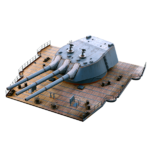
In 1911, when development of the new armored cruisers (future Izmail-class battlecruisers) for the Baltic Sea began, it was already known that ships armed with 343 mm artillery guns were being constructed in England. It was obvious that other countries would soon follow the example of the British and increase the caliber of their new dreadnoughts. In this regard, the Russian Naval Services decided to make 356 mm guns the main weapon of future ships.
It is quite natural that the guns and turrets for the battleships were designed on the basis of the Gangut/Sevastopol-type guns and turrets that had already been put into production. Being very powerful for their time, the 356 mm, 52 caliber guns, developed in 1913 at the Obukhov Plant, were able to fire 748 kg shells at a range of more than 23 km at a maximum turret elevation angle of 25 degrees, according to the project. In 1914, World War I was the reason the Empire's industry diverted to the more pressing issues. As a result, work on neither the battleships nor the turrets was ever completed. The 356 mm gun only was put into operation in test range equipment operated during the Leningrad defense of World War II.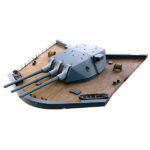
The design of 406 mm sea guns began in Russia in 1914. Up until the end of World War I, future battleships were supposed to be armed with such artillery. The design of the Great Navy battleships began in the U.S.S.R. in 1936. They were also supposed to have 406 mm guns, but the best practices from 20 years ago were no longer suitable. Between 1937 and 1940, the 50 caliber B-37 gun was designed and manufactured at the Bolshevik Plant in Leningrad.
The range tests of the B-37 guns were carried out in the second half of 1940. The firing velocity of a 1,108 kg shell was 830 m/s. The firing range at an optimum elevation angle of 45 degrees exceeded 45.5 km. The B-37 guns were the main weapons of the Sovetsky Soyuz-class battleships. Triple turrets were designed at the Leningrad Metal Plant, which once developed turrets for the first Russian dreadnoughts. The total weight of each mount was about 2,400 tons, and the turret was supposed to be operated in combat conditions by 100 people.Reward
Completing this sub-collection provides the following reward:
| Icon | Details |
|---|---|
| |
Oktyabrskaya Revolutsiya container Chances of obtaining: |
Illustrious Names
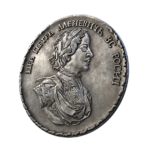
On July 27 (August 9), 1714, during the Great Northern War, the Russian rowing fleet under the command of Admiral Apraksin and Admiral Mikhailov (Peter the Great fought in this battle under the name of the latter) blocked a detachment of Swedish ships near the Gangut peninsula. Peter the Great participated in a boarding battle, as a result of which all ten enemy ships were taken. The Battle of Gangut was the first victory of the Russian regular fleet, and it was greatly celebrated in St. Petersburg.
The following medals were coined in memory of the battle: gold—for officers, silver—for sailors and soldiers. The portrait of Peter the Great wearing a suit of armor and a laurel wreath was on the obverse of the medal. The sea battle, dated July 27, 1714, between the Russian galleys and the Swedish squadron was on the reverse. In 1719, a 90-gun wind-driven battleship named in honor of the battle of Gangut was launched. In 1914, dreadnought battleship Gangut was the fourth ship in the Russian Imperial Navy to carry this glorious name.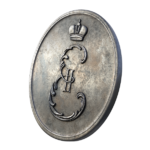
Transformed into one of the world's most powerful fortresses under the guidance of the European engineers, Izmail was a key strong point of the Turkish army on the Danube River in the war of 1787–1791. Russian troops attempted to take the fortress several times with no success. However, in early December 1790, General Alexander Suvorov joined the command of the besiegers, and the fate of Izmail was decided. "I came here with the troops. Twenty-four hours for reflection, and you will be given freedom. My first shot will mean your captivity. When we assault, only death awaits you". This was Suvorov's ultimatum to the Turks. On December 11, 1790, after a violent assault, Izmail fell. Its first commandant was General Mikhail Kutuzov, who distinguished himself during the capture of the fortress and who would later defeat Napoleon in the war of 1812.
Inspired by its success, Catherine the Great awarded all the soldiers, cossacks and sailors who participated in the siege, a silver service medal. The medal was oval-shaped and made of silver. The monogram of the Empress was on the obverse of the medal. The inscription "For Outstanding Bravery During the Capture of Izmail on December 11, 1790" was on the reverse. In June 1915, almost 125 years after this glorious victory, battlecruiser Izmail was launched in St. Petersburg. It was the main cruiser in a series of four ships, each with 32,500 tons of displacement.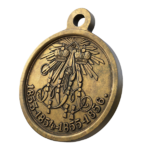
In the morning of November 18 (30), 1853, six Russian battleships under the command of Vitse-Admiral (Vice Admiral) Nakhimov entered the bay of Sinop on the Black Sea coast of Turkey. The enemy squadron was concentrated under the cover of several coastal batteries in the city harbor. At 12:30 pm, the Russian ships opened fire. The Turkish flotilla was destroyed within a couple of hours, and the shore batteries turned into ruins. The Russian squadron lost 37 people. The Battle of Sinop remained in history as the last major battle of the wind-driven fleet era.
Shortly after the end of the Eastern (Crimean) War of 1853–1856, a special medal was established to reward its participants. On its obverse, there were the monograms of Nicholas I and Alexander II, who reigned during the war, and the years: "1853–1854–1855–1856". A quote from the Old Testament was on its reverse side. The medal for the participants of the Battle of Sinop was made of light bronze and it was to be worn on the St. George's ribbon. A 130-gun wind-driven steam battleship named after the victory at Sinop was launched two years after the end of the war. A few decades later, in 1889, squadron battleship Sinop joined the Black Sea Fleet.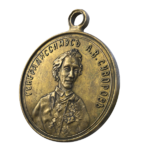
In 1900, Russia celebrated the 100th anniversary of the death of the great Russian commander Generalissimo Alexander Vasilyevich Suvorov (1730–1800). Events dedicated to this date included a decision to establish the Suvorov Museum and to coin a special commemorative badge. The laying of squadron battleship Knyaz Suvorov, taking place in September 1901 in St. Petersburg, was also closely connected with these events.
In 1904, Knyaz Suvorov entered service and became the flagship of the Second Pacific Squadron. In May 1905, the battleship was sunk off Tsushima Island in a battle with the Japanese Navy. Nearly half a century later, in early 1951, a new ship named after the legendary commander was laid down in Leningrad—Project 68-bis light cruiser Aleksandr Suvorov.Reward
Completing this sub-collection provides the following reward:
| Icon | Details |
|---|---|

|
Camouflage Color Scheme - Custom color schemes for the camouflages of all Soviet Cruisers. |
Russian Shipbuilders I
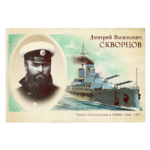
Dmitri Skvortsov was a prominent Russian shipbuilder of the era of armor-plated ships. In 1886, he graduated from the shipbuilding department of the Nikolaev Maritime Academy. Five years later, he was put in charge of monitoring the process of building coastal battleship Admiral Ushakov. Being a chief engineer at a Saint Petersburg port since 1896, he participated in designing pre-dreadnought battleships of the Borodino class and, later, was in charge of building the lead ship of the series. In 1907, Skvortsov was promoted to the rank of General-Mayor (Major General) of the Ship Engineers Corps.
In 1906, the international competition of the projects of a "large high-speed battleship with strong modern artillery" held by the Naval Office of the Russian Empire preferred the project, the development of which was headed by Dmitri Skvortsov. Skvortsov's battleship could have become the first Russian dreadnought battleship—she was a 22,000-ton ship with a turbine propulsion, armed with ten 305 mm guns in five turrets.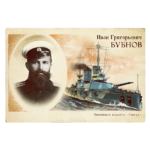
Ivan Grigorievich Bubnov is one of the most prominent Russian shipbuilding engineers. In 1896, after his graduation with honors from the Nikolaev Maritime Academy, he created several projects of large armored cruisers armed with 254 mm and 203 mm artillery. Bubnov was also the chief designer of submarines, including the famous Delfin—the first Russian submarine with an internal combustion engine. In 1912, he received the rank of General-Mayor (major general) of the Ship Engineers Corps.
Between 1907 and 1909, Ivan Bubnov, jointly with another outstanding shipbuilder, Alexei Krylov (1863–1945), developed the project of "battleships with a displacement of 23,000 tons". In June 1909, four ships were laid down as per this project. These were the first Russian dreadnoughts: Gangut, Petropavlovsk, Poltava, and Sevastopol. Later, in 1914, General Bubnov managed the design of even more powerful battleships with a displacement of 35,000 tons, armed with 406 mm artillery.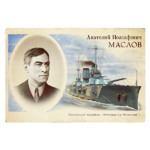
Anatoly Ioasafovich Maslov was an outstanding Russian and Soviet shipbuilder. In 1907, he enrolled in the Ship Engineers Corps of the Russian Imperial Navy, graduating from the Nikolaev Maritime Academy in 1913. He went on to work in the design bureau of the Admiralty Works. In December 1916, Anatoly Maslov was promoted to Podpolkovnik (Lieutenant Colonel) of the Ship Engineers Corps.
Back in 1909, Maslov was appointed assistant builder of battleship Gangut. In 1914, under the supervision of General Bubnov, he developed the project of the "fourth battleship for the Black Sea", soon to became Imperator Nikolai I, and a project of a 35,000-ton battleship with 406 mm artillery. Anatoly Maslov’s contribution to Soviet shipbuilding was even more significant. He was the chief designer of Kirov-class cruisers (Project 26), Maxim Gorky (Project 26-bis) and Chapayev (Project 68).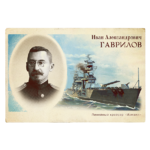
Ivan Alexandrovich Gavrilov was one of the lead shipbuilders in the Russian Empire. In addition to the Nikolaev Maritime Academy, he also took a course at the Higher Electrical Engineering School in Paris. Between 1908 and 1912, Gavrilov was the head of the design bureau of the Admiralty Shipyard and, starting from 1912, was a director of the shipyard in Revel (now Tallinn, Estonia). In 1911, he was promoted to the rank of Polkovnik (Colonel) of the Ship Engineers Corps.
Between 1906 and 1908, Ivan Aleksandrovich Gavrilov developed several innovative projects of lightweight, high-speed cruisers with a turbine power plant. In 1912, his version of the "armored cruiser for the Baltic Sea" was recognized as the best in the international competition, which resulted in the laying down of the Izmail-class battlecruisers the next year. In 1914, Polkovnik Gavrilov created an impressive project of a high-speed battleship with an internal armor belt and sixteen 406 mm guns, mounted in four turrets.Reward
Completing this sub-collection provides the following reward:
| Icon | Details |
|---|---|
| |
Oktyabrskaya Revolutsiya container Chances of obtaining: |
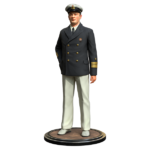
In 1935, Nikolay Gerasimovich Kuznetsov was already an experienced sailor. For more than a year, he commanded cruiser Chervona Ukraina, where he began his service after graduating from the academy in 1926. A talented, devoted commander, who spent all his energy and attention to improving the battle training of the ship, he was highly valued by the commanders and was very respected by the crew. In the autumn of 1935, when the special ranks which had been abolished after the Revolution were introduced for military personnel, Nikolay Kuznetsov, who was 31 years old, was promoted to Kapitan 2 Ranga (Captain 2nd rank).
The Navy Dress Instructions adopted in 1934 strictly defined what uniform and munition items should be used by military personnel depending on the situation. According to these Instructions, the Commander of the Black Sea Fleet could parade his navy coat, white trousers and white shoes along the shore during rare leaves. Four golden galloons with a star decorated the sleeves of a Kapitan 2 Ranga.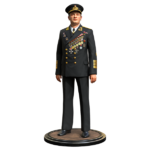
Nikolay Kuznetsov had numerous ups and downs in his career due to conflicts with the highest-ranking Communist party members. Reductions in rank were followed by promotions. In his memoirs, he jokes bitterly about the unique character of his service in the Navy: he was twice a Kontr-Admiral (Rear-Admiral), three times Vitse-Admiral (Vice Admiral), and twice Admiral Flota (Fleet Admiral).
In May 1955, the Fleet Admiral rank was renamed Admiral Flota Sovietskogo Soyuza (Admiral of the Fleet of the Soviet Union). Those who were promoted to Admiral Flota Sovietskogo Soyuza were given Marshal's star. The star was worn on the neck with the parade uniform. Starting from 1952, admirals were supposed to wear parade uniform that included a black coat with golden shoulder marks and a turn-down collar with golden sewing work. The cockade on the peaked cap was also decorated with special sewing work.Reward
Completing this sub-collection provides the following reward:
| Icon | Details |
|---|---|

|
Camouflage Color Scheme - Custom color schemes for the camouflages of all Soviet Destroyers. |
Shells for Battleships
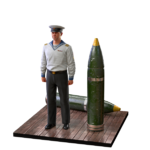
In the Battle of Tsushima of 1905, Borodino-class Russian squadron battleships fired at the Japanese ships with 332 kg Model 1892 shells. The shells were of approximately 2.6 calibers, which limited the amount of explosive agent they could carry to a tiny 5 to 12 kg. The experience from the Russo-Japanese war was taken into account and, in 1907, new elongated shells with a large amount of explosive agent were put into service. However, the design and construction of dreadnought battleships, which began in 1906, required fundamentally more powerful ammunition.
In 1911, a project was approved for a new shell, designed for a 305 mm/52 caliber gun. Ammunition of all three types—armor-piercing, semi-armor-piercing and high explosive—had the same weight of 471 kg. At the same time, AP shells were filled with 13 kg of explosives, which is more than the amount that HE shells of the Russo-Japanese war period contained. The 5 caliber (152 cm) Model 1911 HE shell that contained 61.5 kg of explosive agent was immensely destructive. The magazines Gangut/Sevastopol-class battleships were designed to hold 1,200 305 mm shells, 100 shells per gun.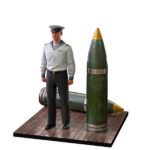
The "Armored Cruisers for the Baltic Sea", which at the design and construction stage turned into Izmail-class battlecruisers, were to carry 356 mm guns as main artillery guns. The increase of the caliber by "only" 51 mm, in turn increased the weight of the the corresponding shell by more than one half. The ammunition of the 356 mm guns had a mass of about 748 kg versus 471 kg for 305 mm cannons.
Two main types of 356 mm shells entered service—the armor-piercing Model 1911 shell and the high-explosive Model 1913 shell. Both had the same weight, differing in the amount of explosive agent and length. The Model 1913 shell was about 170 cm long and was filled with 82 kg of explosives. In accordance with the project, the volume of the magazines of the Izmail-class battlecruisers provided storage of 80 shots per gun, a total of 960 shells.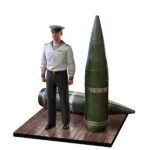
406 mm 50-caliber guns for Sovetsky Soyuz-class battleships (name-code B-37) were among the most powerful naval artillery systems in the world. Their shells were produced by the Bolshevik plant in Leningrad, the design office of which played a major role in the design of the guns themselves.
The main types of ammunition for the B-37 systems were armor-piercing and semi-armor-piercing shells. The weight of each was 1,108 kg. The armor-piercing shell was slightly smaller, but still having a 1.9-meter length it was of rather considerable dimensions. With an initial speed of 830 m/s, such a shell penetrated a 406 mm armor plate from a distance of 13.6 km at a 25 degree angle of incidence. The magazine design capacity of Sovetsky Soyuz-class battleships was 900 shells for main-caliber guns. World War II prevented these mighty ships from being built, but an experimental B-37 cannon was actually used in combat: 81 projectiles were fired at enemy positions from a test site near Leningrad.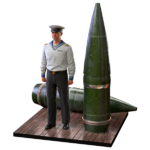
Design calculations for a 457 mm gun, one of the main armament variants for post-war battleships (Project 24), were made in 1949 and provided for a 50-caliber gun barrel. The initial velocity of the 1580 kg shell was 850 m/s, the shell of 1,720 kg had an initial velocity of 820 m/s. The weight and size of the turret with three guns made the displacement of the Project 24 battleships unbearable for the Soviet industry. At the same time, the power of the 50-caliber gun was excessive, based on the characteristics of battleships that were part of foreign fleets at that time.
Reducing the length of the 457 mm gun barrel to 48 calibers would provide a 1,580 kg shell with an initial speed of about 800 m/s, which guaranteed penetration of the armor of Iowa-class American battleships, the main suspected opponent of the project 24 ships, at all reasonable angles and flight paths. Based on the similar characteristics of the 406 mm shells for B-37 guns, the ammunition for the 457 mm gun would have been over 2.1 m long, with an explosive weight ranging from 36 to 128 kg, depending on the shell type: armor-piercing or explosive.Reward
Completing this sub-collection provides the following reward:
| Icon | Details |
|---|---|
| |
Oktyabrskaya Revolutsiya container Chances of obtaining: |
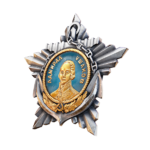
In March 1944, in the midst of the War, the Order of Ushakov was established in the U.S.S.R., becoming the highest award specially designed for Navy officers. The order got his name in honor of Admiral Fyodor Ushakov, one of the greatest Russian naval commanders (1745–1817). The order was established in two classes. The 1st Class order was a five pointed platinum star with silver anchor and chain secured to it, and an enamel covered medallion struck from gold with the relief image of a naval commander. The star of the 2nd Class order was made of gold, and the anchor and the medallion were made of silver.
The Order of Ushakov was a very rare award—only 26 people received the 1st Class honor. In June 1944, Admiral Nikolay Gerasimovich Kuznetsov was awarded with the Order Badge No. 5. A year later he was awarded with the second 1st Class Order of Ushakov. The only foreigner who was awarded with this order was the British Royal Navy Admiral Bertram Ramsay, one of the Commanders of the Dunkirk evacuation in 1940 and the Normandy landings in 1944. Interestingly, the Order Badge No. 1 of the 2nd Class Order of Ushakov was awarded to a distant relative of Fyodor Ushakov, and participant of two world wars, Kontr-Admiral (Rear Admiral) Yury Fyodorovich Rall (1890–1948).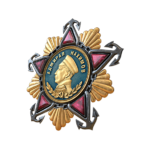
Simultaneously with the Order of Ushakov, in March 1944, an Order was established in honor of another famous Russian naval commander, Admiral Pavel Nakhimov (1802–1855), defender of Sevastopol and a hero of the battles of Navarino and Sinop. The badge of the Order of Nakhimov, 1st Class, was made of gold and silver encrusted with rubies.
One of the recipients of the Order of Nakhimov, 1st Class, was Admiral Yury Aleksandrovich Panteleyev (1901–1983). During the 1920s, Admiral Panteleyev, along with the future Commander-in-Chief of the Naval Forces, Nikolay Kuznetsov, served on cruiser Chervona Ukraina. During World War II, he was in command of the naval defense of Leningrad, and the Belomor Military Flotilla. In his last military position, Admiral Panteleev participated in the protection of the Arctic convoys and in providing assistance for the bombing of German battleship Tirpitz by British aviation. However, an even greater fame fell upon the Admiral as a brilliant yachtsman, who had dedicated seven decades of his life to sailing.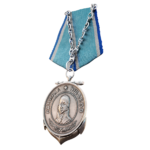
The Medal of Ushakov was established in March 1944 along with a same-name order, becoming a naval equivalent of the much respected among war veterans Medal for Courage. On the face of the silver-made award was a portrait of the Russian naval commander Admiral Fedor Ushakov (1745–1817). This medal was awarded to sailors and starshinas of the U.S.S.R. Navy for bravery and gallantry demonstrated in battle during naval operations. In rare cases, junior officers could be awarded with this medal, too.
The initiator of special naval orders and medals awarded at the height of World War II was Nikolay Gerasimovich Kuznetsov, People's Commissar of the U.S.S.R. Navy. He knew the history of the navy well, and during and after the war he put a lot of effort into bringing the heroic deeds of Admiral Ushakov, who had never lost a single battle in his life, back from oblivion.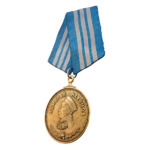
The fourth naval award established at the initiative of Admiral Kuznetsov in March 1944 was the Medal of Nakhimov. It was essentially an analogue of the ground forces medal called "For Battle Merit", and was awarded to navy servicemen ranking up to Praporshchik (Warrant Officer). The medal was made of bronze, and its face depicted a portrait of Admiral Pavel Nakhimov (1802–1855), one of the heroes of the defense of Sevastopol and winner of the Battle of Sinop.
In total, over 14,000 people were awarded the Medal of Nakhimov for their heroic deeds. The first to be awarded with this medal in April 1944 were reconnaissance sailors of the Northern Fleet F.G. Moshkov, E.V. Tolstov, and M.A. Kolosov. Among the few awarded twice was a Red Navy sailor named Ivan Petrovich Meka, a machine gunner on one of the torpedo boats of the Baltic Fleet.Reward
Completing this sub-collection provides the following reward:
| Icon | Details |
|---|---|

|
Second Flag - Ability to mount a second flag on all Soviet Destroyers. |
Russian Shipbuilders II
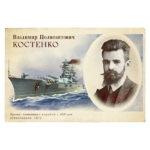
Vladimir Polievktovich Kostenko is a legendary figure in the history of Russia of the 20th century. As a young mechanic and engineer, he participated in the famous Battle of Tsushima. Upon his return from Japanese captivity, he was sent to England to observe the construction of armored cruiser Rurik, the flagship of the Baltic Fleet during World War I. As a person of principle, both politically and professionally, Kostenko was repeatedly subjected to repression both under the tsarist government and during the Soviet period—he was a prisoner of the Peter and Paul Fortress and the Stalin camps.
In 1912, he was placed in charge of the design bureau of the shipbuilding plant in the city of Nikolaev. Kostenko took part in the design and construction of a number of ships and vessels for the Black Sea Fleet, including battleship Imperator Nikolai I. In late 1916–early 1917, using a number of progressive design solutions implemented in the battleship, he developed several versions of the draft project for a high-speed battleship with a displacement of about 45,000 tons, armed with 406 mm main guns.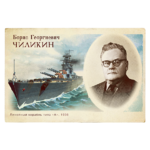
In the history of Soviet military shipbuilding, Boris Georgievich Chilikin occupies a prominent place. From 1930, he worked in the design bureau of the Baltic Works (KB-4), and headed the upgrade works on battleships Marat, Oktyabrskaya Revolutsiya (formerly, Gangut), and Parizhskaya Kommuna. In 1936, Chilikin took the position of Chief Designer of the Design Bureau of Baltic Works.
By the mid-1930s, Soviet industry had grown strong enough, and the country's leadership decided to start building powerful battleships of a new generation. One of the first to appear in 1936 was Project 21, created by the Design Bureau headed by Boris Chilikin. It was a battleship with triple 406 mm turrets all concentrated on the ship's bow. A little later, he developed the "Type A battleship", which served as basis for Project 23, a 46,000-ton ship protected by a 380 mm armor belt. In July 1938, under Project 23 where the Chief Designer was Chilikin, the lead ship, Sovetsky Soyuz, was laid down, as the lead ship in a series of four.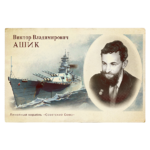
Among Russian and Soviet engineers, there have always been a lot of bright personalities. Viktor Vladimirovich Ashik was no doubt one of them. His ancestors came from Serbia. Viktor himself, with over six decades of experience in designing and building ships, was a hereditary collector and a brilliant connoisseur of world culture and history.
In 1936, being an employee of the Design Bureau of the Baltic Works, Ashik became the deputy of Boris Chilikin who was in charge of Project 23, which envisaged the construction of a battleship for the Great Ocean Fleet. In 1939, Ashik became the Chief Designer for the project under which, by that time, two of the four Sovetsky Soyuz-class ships had already been laid down. During the War, at the insistence of the People's Commissar of the Navy Admiral Kuznetsov, who correctly assessed the leading role of carrier-based aviation in a war at sea in those days, the first aircraft carrier projects were under development in the U.S.S.R. After being promoted to the position of Chief Engineer of Central Design Bureau No. 17, Viktor Ashik headed the design works on Soviet aircraft carriers.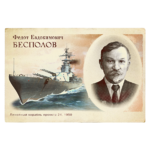
The path to become a shipbuilder was long and difficult for Fedot Evdokimovich Bespolov. Born into a poor family, he entered a higher educational establishment shortly before the beginning of World War I, so he had to juggle his studies and work at a port. A number of times he had to abandon his studies and work at dockyards to feed himself. After receiving the specialty of a ship constructor in 1930, Bespolov was involved in the design and construction of the Leningrad-class destroyer flotilla leaders.
From the mid-1930s, Fedot Bespolov worked at the Central Design Bureau of Special Shipbuilding No. 1, later known as Central Design Bureau No. 17, taking part in designing Gnevny-class destroyers. In 1939, a talented engineer was appointed to the post of chief designer of the Project 69, Kronshtadt-class super heavy cruisers armed with 305 mm artillery. In the midst of the Great Patriotic War, Bespolov led the development of Project 24, a further development of Sovetsky Soyuz-class battleships. The design of these ships was to take into account the experience of World War II and embody the most advanced achievements of Soviet shipbuilding. Both 406 mm and 457 mm guns were considered as options for battleships armament. Besides, in accordance with the project designed at 1950, they had to be equipped with the most advanced universal artillery and the latest radar equipment.Reward
Completing this sub-collection provides the following reward:
| Icon | Details |
|---|---|
| |
Oktyabrskaya Revolutsiya container Chances of obtaining: |
Overall Reward
Completing the entire collection provides the following rewards:
| Icon | Details |
|---|---|

|
Camouflage Color Scheme - Custom color schemes for the camouflages of all Soviet Battleships. |

|
Second Flag - Ability to mount a second flag on all Soviet Battleships. |
Notes
- More information can be found here: All About the "In the Service of the Motherland" Collection.
